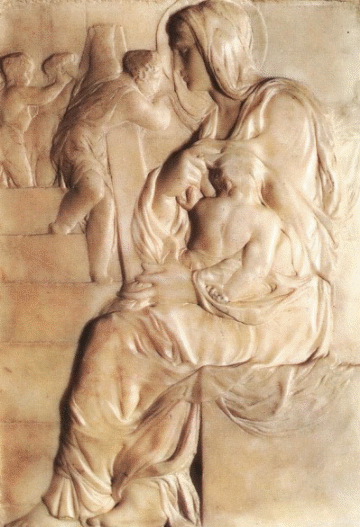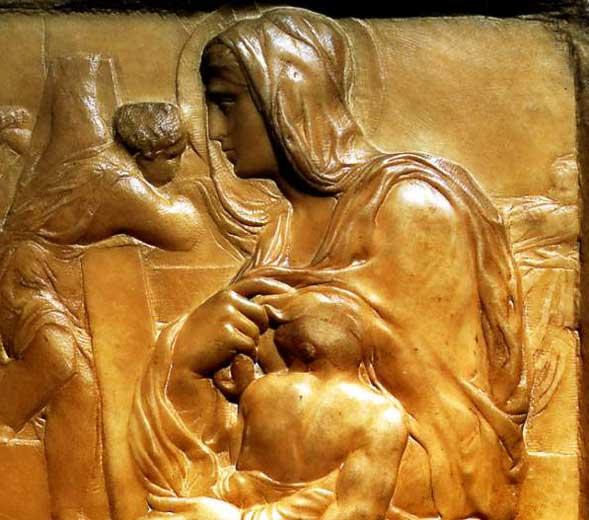
Madonna of the Stairs is one of the earliest known sculptured works of Michelangelo. It was created when he was only fifteen or sixteen years old (Michelangelo Buonarroti, & Goldscheider, 1975). The sculpture is important from a historical perspective because it helps the beholder to grasp the enormity of Michelangelo’s genius as well as his unique approach to the canons of Christian iconography. The aim of this paper is to provide a critical analysis of the sculpture.
Identity Information
- Artist’s Name: Michelangelo
- Title: Madonna of the Stairs
- Year of production: circa 1490
- Medium: Marble
- Dimensions: 56.7 x 40.1 cm
- Present location: Casa Buonarroti, Florence (Müntz, 2011).
What I See
Madonna of the Stairs is a relief sculpted by Michelangelo. The sculpture presents Mary sitting on a stone of square shape. The figure fills the entire foreground of the sculpture. Madonna holds her Child; however, she does not gaze at him, but rather looks into the distance. The background is filled with three figures and stairs. Jesus is tightly pressed to his mother’s chest, and it is not clear whether he is nursing or sleeping. However, taking into consideration that the Child holds his right arm behind his back in a relaxed position, it could be argued that he is sleeping. Moreover, Mary grasps Jesus’s feet, also suggesting that she is protecting his sleep. The Child’s head is half covered in drapery from which the viewer glimpses only one ear. The face of the Child is partially hidden under the Madonna’s robe. However, it is clear that the sculpture does not depict a mortal child: The right arm that rests behind the Child’s back is extremely muscular. It could be argued that he is of a Herculean build. The Madonna assumes a relaxed position, as is clear from the way she crosses her legs and slightly leans forward. Her halo does not fit in the sculpture—part of it runs out of the frame.
The figures depicted in the sculpture are so light and fluid that they create an impression of pencil drawings. Indeed, even though the sculpture is carved in stone, it looks nothing like similar art objects. It does not seem massive; rather it is reminiscent of a depiction created with a waxy substance.
What My Research Has Taught Me
Madonna della Scala is a relief sculpted by Michelangelo di Lodovico Buonarroti Simoni. It is sometimes referred to as Madonna of the Steps or Madonna of the Stairs (The Michelangelo Experience, 2010). It is the earliest known work of the sculptor. Madonna of the Stairs was created when Michelangelo was around the age of fifteen or sixteen (Müntz, 2011). He started working on the sculpture after the end of his apprenticeship with the most famous Italian painter of the time—Domenico Ghirlandaio (Fejfer, Fischer-Hansen, & Rathje, 2003). However, after only one year, Michelangelo decided that there was nothing more for him to learn. Later, he became one of the most famous sculptors in Italy. It should also be noted that Michelangelo is recognized as an unparalleled painter, poet, and architect who has made a significant contribution to the development of Western art (Müntz, 2011). Furthermore, he is considered one of the most prolific creators of the High Renaissance era and is often ascribed the role of a typical Renaissance man (Müntz, 2011).
According to Bull (1996), Michelangelo intended to keep the Madonna of the Stairs for himself. Indeed, it was owned by Buonarroti family up until the sculptor’s death. The master’s nephew Leonardo presented it as a gift to Duke Cosimo I. However, his descendant Cosimo II returned Madonna of the Stairs to the sculptor’s family out of respect for Michelangelo’s genius (Müntz, 2011).
The fact that Michelangelo managed to produce a sculpture of such remarkable complexity at such a young age indicates that he was extremely talented even in his early adulthood. His genius is also evident from the fact that Madonna of the Stairs is executed in rilievo schiacciato—Donatello’s technique that was appreciated by Michelangelo (Wallace, 2012). This method of marble carving is associated with an extremely delicate process of chiseling out small pieces of material in order to create the illusion of recession in relief. Therefore, it seems that the artist softened barriers between the Madonna, placed in the foreground, and the background of the sculpture. It is truly astonishing that an inexperienced sculptor was able to create Madonna of the Stairs using Donatello’s technique.
According to Hartt (1976), Domenico Ghirlandaio was not Michelangelo’s real teacher. The writer argues that the young sculptor had spent many hours taking lessons from “sculptors long since dead” (Hartt, 1976, p. 23). He believes that the level of control of stone and tools necessary for executing Madonna of the Stairs were learned from imitation of works by Antonio Rossellino, Antonio del Pollaiuolo, and Andrea del Verrocchio (Hartt, 1976). However, it is even more remarkable that Michelangelo abandoned the archetypical representation of Mary and Jesus and did not want to follow the compositional template of influential painters and sculptors of his time (Renaissance Masters, 2015). Instead, the young sculptor decided to take a novel approach to composition that was popular among Florentine masters of sculpture such as Desiderio da Settignano and Medici’s sculptor Bertoldo di Giovanni (Renaissance Masters, 2015). At that time, it was extremely unusual to execute a picture or a sculpture that did not depict Madonna looking at the Child.
It should be noted that numerous scholars believe that Michelangelo was also strongly influenced by Jacopo and Giacomo della Quecia (Müntz, 2011). They claim that the master’s fourteen-century forebears brought “charm, purity, and refinement” (Müntz, 2011) into his works. A case in point is a series of St. Sebastian sculptures produced by Mino da Fiesole, Antonio Rossellino, and Benedetto da Maiano (Müntz, 2011). Moreover, Müntz (2011) goes so far as to claim that Madonna of the Stairs is copied from “a low-relief attributed to Desiderio de Settignano” (p. 34). According to Bull (1996), the sculpture closely follows Donatello’s style “in its shallow carving and in the use of small figures on the stairs and leaning over the balustrade” (p. 21). The writer also suggests that the figures on the background of the relief were inspired by “the pulpit sculptures at Pistoia by Giovanni Pisano, as well as Bertoldo’s bronze” (Bull, 1996, p. 21).
Composition
Madonna of the Stairs depicts “a monumental nursing mother, haloed, elaborately draped, in heroic profile” (Bull, 1996, p. 20). Mary is a central figure in the relief. It could be argued that the relaxed body of the Child and prominent display of his muscular back emphasize his divinity. Moreover, the astounding exercise of marble relief executed in rilievo schiacciato where figures scarcely rise from the background helps a viewer to constantly recognize that the Mother holds in her hands not a mere mortal but God (Smithers, 2016).
According to Bull (1996), “the outstretched arms of one of three wingless putti form a cross with the stone baluster as he gathers up a winding sheet” (p. 20). It could be argued that by shaping the background of the sculpture into a cross, Michelangelo added an invisible layer of religious symbolism to the composition of the relief. Moreover, placing such a powerful symbol above the Madonna and the Child, the master “combined majestic and almost sepulchral stillness” (Bull, 1996, p. 20) with a portentous message of life and hope. Even though it seems that the relief exudes tranquility, “the powerful mother’s large hands and agitated draperies and the infant’s head, shoulder and curling fingers” form “a circle of energy that whirls round in the centre of the creamy marble” (Bull, 1996, p. 20).
Interpretation
Contrary to all canons of Christian iconography, Michelangelo created an image of the Madonna whose halo goes beyond the relief’s plane. It could be argued that the young sculptor wanted to show that the figure is godly by nature but is not removed from the everyday world.
Clearly, defying the traditional presentation of the Madonna and Child was an extremely unconventional move for Michelangelo’s time. According to Franklin and Kaplan (1994), Michelangelo rejected the idea of a Tuscan Madonna and did not want to present Mary “as a young bourgeois with Jesus depicted as the blessing savior” (p. 123). Figure 1 shows a fragment of the sculpture (The Madonna of the Stairs 1491/92, n.d.).

According to Hibbard (1985), Madonna of the Stairs represents an idea that was popular in fifteenth-century Italy: Mary was often compared to a stairway that connects God in the form of Jesus with mortals. It was said that the stairway could help people to ascend to Heaven and reunite with the Father (Hibbard, 1985). However, it could be argued that the marble sculpture of the Madonna and the Child was more than a religious artifact for Michelangelo. Hibbard (1985) argues that Mary’s gaze into nothingness is reminiscent of funerary portraits. Taking into consideration the fact that the master’s mother died when he was only six years old, it could be said that the unusual depiction of Mary is an allusion to his mother’s death (Weinberger, 1967).
Art Historical Style
In terms of art historical style, Madonna of the Stairs belongs to the period of the Italian Renaissance, particularly the High Renaissance. It is generally agreed that the period started in the 1490s and ended in 1527 (Weinberger, 1967). It was associated with exceptionally prolific artists in Italy, such as Leonardo da Vinci, Michelangelo, and Raphael. To this date, there is no agreement among art scholars whether the relief is the first or the second sculpture of the master. Although it is strongly reminiscent of the Pazzi Madonna by Donatello, it could be argued that Michelangelo drew his inspiration from multiple sculptors’ works (Franklin & Kaplan, 1994).
Personal Assessment
After conducting extensive research on Madonna of the Stairs, it has become clear to me that Michelangelo is one of the most prominent figures of the Italian Renaissance whose genius was evident from his early adulthood. Taking into consideration the fact that the relief was executed in Donatello’s technique, rilievo schiacciato, it becomes clear why Madonna of the Stairs is regarded to be as significant as most of his later works. The research helped me to understand that the sculpture had a deep personal meaning to Michelangelo and was associated with his mother’s death.
References
Bull, G. (1996). Michelangelo (1st ed.). New York, NY: St. Martin’s Press.
Fejfer, J., Fischer-Hansen, T., & Rathje, A. (2003). The rediscovery of antiquity (1st ed.). Copenhagen, Denmark: Museum Tusculanum Press.
Franklin, M., & Kaplan, B. (1994). Development and the arts (1st ed.). Hillsdale, NJ: Lawrence Erlbaum Associates.
Hartt, F. (1976). Michelangelo: the complete sculpture. New York, NY: Abrams.
Hibbard, H. (1985). Michelangelo (2nd ed.). Cambridge, MA: Harper & Row.
Michelangelo Buonarroti, & Goldscheider, L. (1975). Michelangelo (1st ed.). London, England: Phaidon.
Michelangelo, Madonna of the Stairs [Image]. (n.d). Web.
Müntz, E. (2011). Michelangelo (1st ed.). New York, NY: Parkstone International.
Renaissance Masters. (2015). Madonna della Scala. Web.Smithers, T. (2016). Michelangelo in the new millennium: conversations about artistic practice, patronage and Christianity. Boston, MA: Brill.
The Madonna of the Stairs 1491/92 [Image]. (n.d). Web.
The Michelangelo Experience. (2010). Madonna della Scala (Madonna of the Stairs). Web.
Wallace, W. (2012). Discovering Michelangelo: the art lover’s guide to understanding Michelangelo’s masterpieces. New York, NY: Universe Publishing.
Weinberger, M. (1967). Michelangelo, the sculptor. London, England: Routledge.